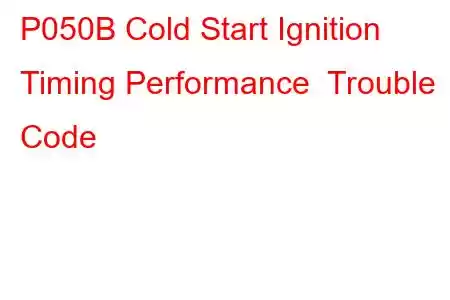P050B Cold Start Ignition Timing Performance
OBD-II Trouble Code Technical Description
Cold Start Ignition Timing Performance
What does that mean?
This generic powertrain diagnostic trouble code (DTC) typically applies to many OBD-II vehicles. That may include but is not limited to vehicles from Jeep, Jaguar, Dodge, BMW, Land Rover, Toyota, VW, Ford, Mitsubishi, Mazda, etc.
If your OBD-II vehicle has stored a code P050B, it means that the powertrain control module (PCM) has detected a malfunction in the ignition timing control system. Cold start is a term used to describe an engine drivability strategy that is implemented only when the engine is at (or below) ambient temperature.
The PCM calculates ignition timing strategy (including during cold start) using input data received from the crankshaft position (CKP) sensor, the camshaft position (CMP) sensor, the engine temperature sensor (ECT), throttle position sensor (TPS), and the mass airflow (MAF) sensor, among others.
Since OBD-II vehicles are equipped with distributor-less ignition systems, the PCM is programmed to deliver a base timing strategy and to advance and retard ignition timing as required. Changes in engine load and RPM demand varying degrees of ignition timing to help optimize engine performance and maximize fuel efficiency.
When the engine is cold, timing is advanced slightly to compensate for the lower combustion chamber temperature. In the event that the engine overheats or when knock sensors are activated, ignition timing is retarded by the PCM to prevent engine damage.
If ignition timing cannot be controlled by the PCM, a code P050B will be stored and a malfunction indicator lamp (MIL) may be illuminated. Most vehicles will require multiple ignition cycles with a failure for MIL illumination.
Cold car:
What is the severity of this DTC?
Incorrect ignition timing may contribute to catalytic converter damage, poor engine performance, and diminished fuel efficiency. A code P050B should be categorized as severe and dispatched with haste.
What are some of the symptoms of the code?
Symptoms of a P050B engine code may include:
Excessively rich exhaust Engine stall at idle Pinging noise upon acceleration CKP or CMP sensor related codesWhat are some of the common causes of the code?
Causes for this code may include:
Defective ECT sensor Severe vacuum leak Open or shorted circuits or connectors Bad CKP or CMP sensorWhat are some P050B troubleshooting steps?
Diagnose and repair ECT, CKP, or CMP related codes before attempting to diagnose the P050B.
When diagnosing a code P050B, I would gain access to a source of reliable vehicle information, a diagnostic scanner with an integrated oscilloscope, and a digital volt/ohmmeter (DVOM).
You will need diagnostic flow charts, wiring diagrams, connector face views, connector pin-out charts, and component testing procedures and specifications to accurately diagnose a code P050B. This information can be found in your source of vehicle information.
Note: We are aware of a few technical bulletins put out by manufacturers. For example, one is for Jeep, #18-011-13, and one for Jaguar #XJ303-014 specific to this P050B diagnostic code.
Perform a visual inspection of all vacuum lines and hoses, wiring harnesses, and related connectors. CKP or CMP sensor connectors that are contaminated with oil should be cleaned or replaced (sensor and connector).
Connect the oscilloscope (as described below) and prepare to initiate a cold engine start. Be careful to route scope test leads away from moving parts.
Test the CKP and CMP sensors using the oscilloscope:
Probe the signal circuit of the sensor with the positive test lead of the scope The negative test lead should be connected to the sensor ground wire CKP and CMP sensor referenceRead: 41


